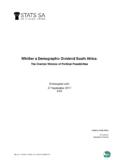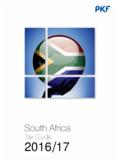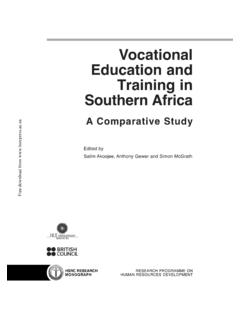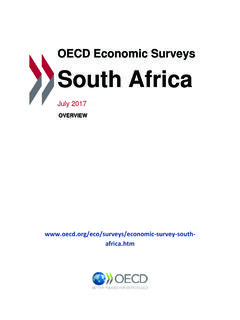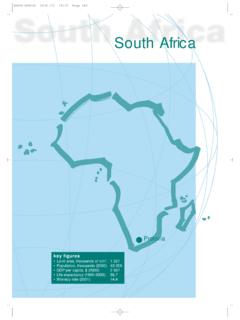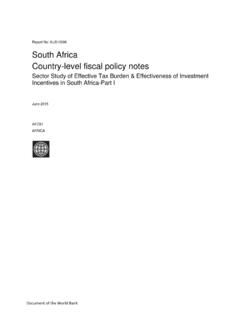Transcription of Fuel Prices in South Africa How it is calculated2
1 fuel Prices in South Africa How is it calculated? The petrol pump price is composed of a number of price elements and these can be divided into international elements and domestic elements. The international element, or Basic fuel price (BFP), is based on an import parity principal. In other words, it is what it would cost a South African importer of petrol to buy the petrol from an international refinery, transport the product from that refinery, insure the product against losses at sea and land the product on South African shores. Composition of the Petrol Pump Price 93 Octane(Gauteng) in SA cent per litre 502 c/l - 06 April 2005 Basic fuel price& Slate live ry cost7 tax116 sto m s & Ex ci se4 Composition fo the Diesel Estimated Pump Price (Gauteng) in SA cent per litre 514 c/l - 06 April 2005"Deemed"Retail fuel price& Slate ry cost7 dye sto m s & Ex ci se4 tax100 Note Diesel Retail price not regulated, retail margin estimated to be similar to regulated retail margin on petrol Now for some more detailed explanation of the terminology used above in the graph.
2 1. Basic fuel Price (BFP) The In Bond Landed Cost (IBLC) was first introduced in the 1950 s with the establishment of the first refinery in South Africa , and was previously revised in 1995, when a market spot price component was introduced. In a world constantly changing, the use of refinery gate Prices posted by international refiners known as postings, has become somewhat anachronistic in world trade and no longer track international market Prices consistently. This has resulted in the IBLC losing credibility as a reasonable proxy for international fuel Prices . The Basic fuel Price (BFP) formula has replaced the IBLC formula, with effect from 2 April 2003. This formula was negotiated in a positive spirit, with government and industry (AMEF & SAPIA) agreeing on the new pricing formula, maintaining an import parity price structure.
3 The BFP formula reflects the realistic cost of importing a litre of product from international refineries with products of a similar quality compared to local South African specifications on a sustainable basis. This element changes on the first Wednesday of every month based on the average daily international price movements and exchange rate fluctuations from the 26th of the previous month the 25th of the month preceding the price change. BFP consists of a number of elements as it is based on import parity, reflecting the cost of what an actual import of product would cost. Components include: Petrol = 50% of Singapore PricesDiesel & Kero: 50% of Arab Gulf PricesPetrol, Diesel & Kero: 50% of Med PricesFreight, Demurrage, Insurance, LossesLanding & wharfage, Storage & Finance cost International market spot Prices The largest component of the basic fuels price is the price that one would be paying on international markets when physically importing product to South Africa .
4 The FOB (Free on ship s board) product Prices from different locations in the world, based on international product availability and product quality, are used. The petrol FOB price is calculated as 50% of the Mediterranean spot price for Premium unleaded petrol and 50% of the Singapore spot price for 95 Octane unleaded petrol. For the FOB price of Diesel, the new BFP formula use spot Prices calculated as 50% of the Mediterranean price for Gas oil and 50% of the Arab Gulf price for Gas oil, plus the quoted spot price market premiums applicable. Freight cost to bring product to South African ports The freight component of the BFP reflects the cost of voyages from Augusta (in the Mediterranean), Singapore and Mina-al-Ahmadi (in the Arab Gulf), in 50:50 combinations as appropriate to the international markets used in the FOB calculations of the products concerned.
5 Tariffs as published by the World Scale Association for transporting refined products via medium-range vessels to a weighted average for South African coastal ports, plus demurrage for an average 35 000 ton vessel for 3 days, adjusted with the Average Freight Rate Assessment (AFRA) of the London Tanker Brokers Panel, plus a 15% premium for transporting fuels to South Africa . Insurance costs Calculated as of the product FOB and freight costs, to cover insurance cost, as well as other costs such as letters of credit, surveyors and agents fees, and laboratory costs. Ocean loss allowance In international petroleum products trading, shipping and insurance, a loss of for products has been accepted as a normal leakage/clingage and evaporation loss.
6 Simply put, this means that the normal loss is not insurable and has to be accepted by the buyer. The buyer therefore has a financial loss of of FOB, Insurance and Freight costs. Wharfage The BFP calculates Wharfage charges in terms of the ruling National Ports Authority of South Africa contract tariffs for petroleum products , currently being R18,72 per kilo-litre. Coastal Storage This element is to cover the cost of providing storage and handling facilities at coastal terminals. Storage is calculated based on the typical cost of international product storage of $3 per ton per month for 25 days worth of stock, currently SA c/l per month. This cost factor is escalated annually in accordance with movements in the Producer Price Index as at June of each year.
7 Stock Financing Cost The BFP includes a charge for the financing of 25 day s stock at an interest rate of 2 percentage points below the ruling prime rate of the Standard Bank of South Africa . The BFP as determined above is converted to SA cents per litre by applying the applicable SA Rand/US Dollar exchange rate (four banks selling rates at eleven o clock averaged over the period 26th of the previous month to 25th of the month before the price change), and a constant litre per gallon factor of for petrol. 2. Domestic Elements To arrive at the final pump price in the different pricing zones (magisterial district zones) certain domestic transport costs, government imposts, or taxes and levies and retail and wholesale margins needs to be added to the international price.
8 A. Transport costs (Zone differential) Keeping in mind the import principle used, this element recovers the cost of transporting petroleum products from the nearest coastal harbour (Durban, Port Elizabeth, East London, Mossel Bay or Cape Town) to the inland depot serving the area or zone. Transport to the different pricing zones are determined by using the most economical mode of transport pipelines (C zones), road (B zones) or rail (A zones). This is the only element which values differ per pricing zone, and is the reason why the petrol price is not the same for the whole country. b. Delivery costs (Service differential) This element compensates marketers for actual depot related costs (storage and handling) and distribution costs from the depot to the end user at service stations.
9 The value is calculated on actual historical costs of the previous year, averaged over the country and industry. c. Wholesale (Marketing) margin Money paid to the oil company through whose branded pump the product is sold, to compensate for marketing activities. This margin is controlled by the government, allowing for changes based on the oil companies return on their marketing assets. The formula used to determine the wholesale margin is based on the results of a cost/financial investigation by a chartered accountant firm into the profitability of the wholesale marketers. The level of the margin is calculated on an industry basis and is aimed at granting marketers a return of 15% on depreciated book values of assets, with allowance for additional depreciation, but before tax and payment of interest.
10 D. Retail margin The retail margin is fixed by DME and is determined on the basis of actual costs incurred by the service station operator in distributing petrol. Account is taken of all proportionate driveway related costs such as rental, interest, labour, overheads and profit. The way in which the margin is determined creates an incentive to dealers to strive towards greater efficiency, to beat the average and to realise a net profit proportionate to their efficiency. e. Equalisation Fund levy The statutory fund levy is a fixed monetary levy, and the fund is regulated by ministerial directives issued by the Minister of Mineral and Energy Affairs in concurrence with the Minister of Finance, as laid down by the Central Energy Fund Act, No 38 of 1977 as amended In terms of Ministerial Directives the Fund is principally utilised to smooth out fluctuations in the price of liquid fuels through slate payments; to afford synfuel producers tariff protection and to finance the crude oil premium (price differential applicable to SA oil purchases during the late 1970 s).

